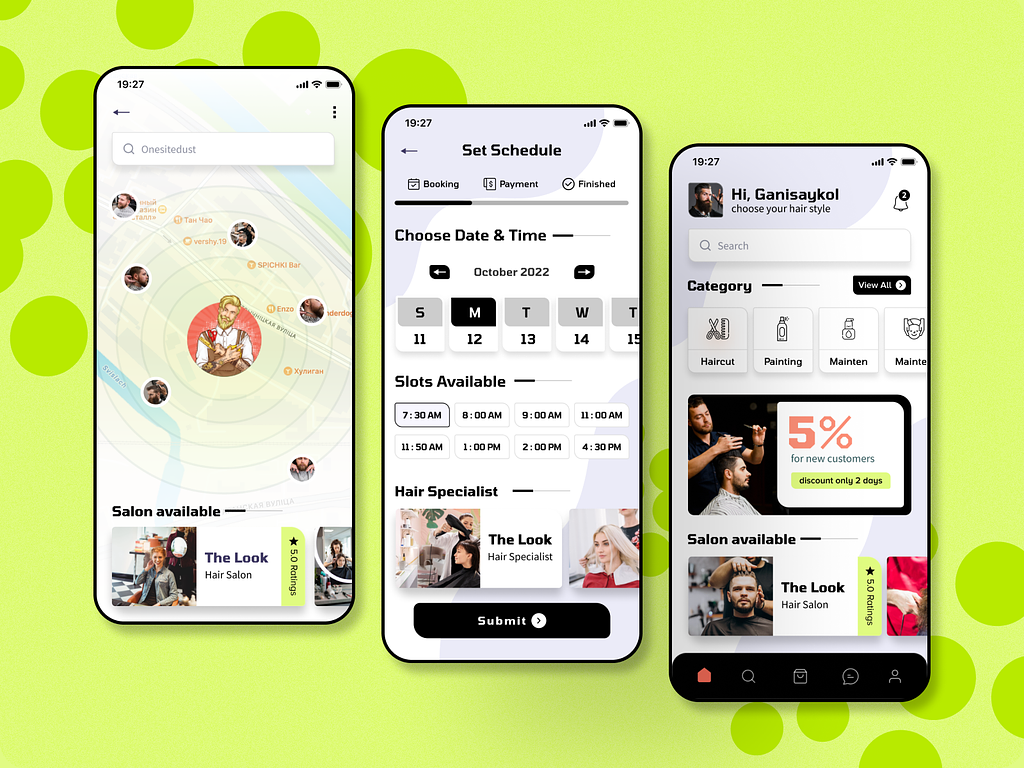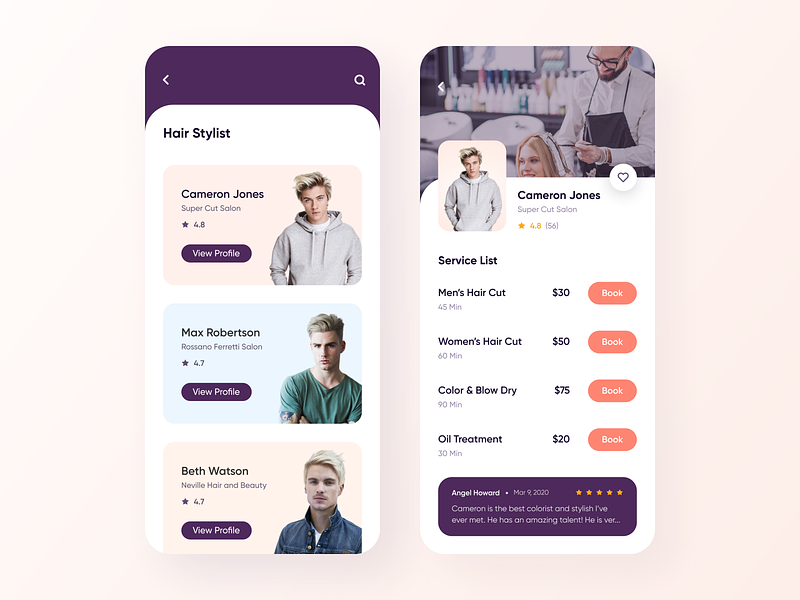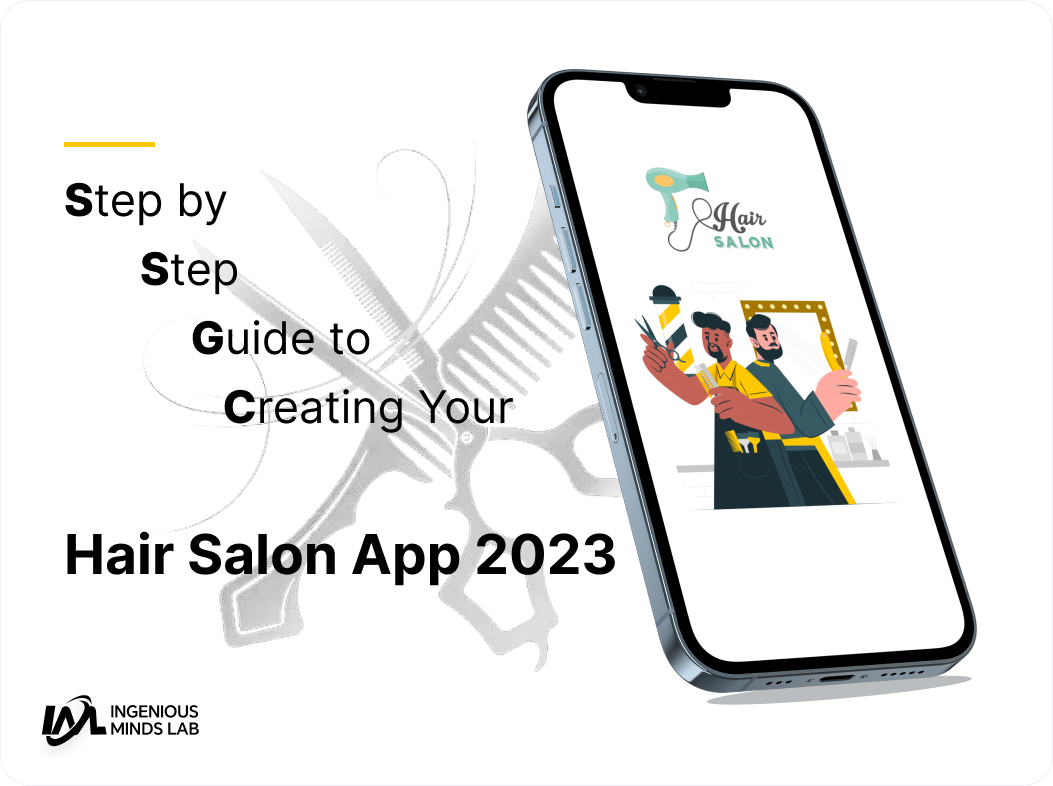In today’s digital world, efficiency and convenience reign supreme, leading to a surge in demand for on-demand app development companies. The beauty and wellness sector, in particular, has wholeheartedly embraced this technological revolution.
Gone are the days of enduring long queues or making endless phone calls to schedule appointments at hair salons. Thanks to salon appointment booking apps and on-demand beauty services apps, customers can now effortlessly book their salon visits and access a wide range of beauty services right at their fingertips.
In this article, we will explore the captivating realm of starting a hair salon app and unveil the crucial steps required to embark on this transformative journey armed with comprehensive market knowledge.
To thrive in the fiercely competitive beauty market, it is vital to incorporate the right features when developing a hair salon app. Harnessing the power of iPhone app development and Android app development services is essential in tapping into a world of opportunities for your business, considering the widespread usage of smartphones. This blog will delve into the key elements that can make a significant difference for your startup in the realm of beauty salon app development. So, let’s delve into the essential components of a salon appointment scheduling app.

For Customers:
- User Registration: Simplify the registration process by allowing users to sign up using their email addresses, phone numbers, or social network accounts. Gather necessary data like name, phone number, and address to improve the user experience and enable online product sales if applicable.
- Product and Service Showcase: Create a personalized mobile catalog where customers can easily browse a variety of services and products. Showcase different haircuts, offer lookbooks, and highlight enticing beauty salon packages with exciting discounts to encourage service purchases.
- Mobile Appointment Booking: Streamline the booking procedure by providing customers access to a comprehensive service catalog. Allow them to choose their preferred salon and book appointments directly from the app. Incorporate a built-in calendar tool that sends confirmation notifications to both the customer and salon owners. Simplify the process for customers to book additional salon services, enhancing user satisfaction.
- Style Inspiration Gallery: Attract customers by showcasing stunning photos of hairstyles, haircuts, and cosmetic procedures. Include a separate navigation menu featuring looks inspired by celebrities and movies, offering styling tips and showcasing salon equipment. These visual elements serve as effective marketing tools, enticing clients to choose your salon for their desired looks.
- Salon Information: Provide customers with detailed information about the salon, including the owner’s background, years of experience, services offered, and contact information. This feature instills confidence in customers and empowers them to make informed decisions.
- Upcoming Appointments: Include a section that displays clients’ upcoming salon appointments to ensure they never miss a service. Allow clients to cancel appointments if needed and provide information about services, dates, operating hours, and any special requests made to the salon.
- Loyalty Rewards and Special Deals: Encourage customer loyalty by offering rewards such as loyalty points for each purchase made through the app. Provide discounts or free services to clients who avail multiple services. These tactics promote repeat business and foster long-lasting relationships with customers.
- Push Notifications: Engage users by sending push notifications to keep them informed about app features. Notify them about mobile bookings, cancellations, limited-time deals, and special discounts. This feature enhances user engagement and generates interest in salon services.
- Save Favorites: Enhance user convenience by allowing clients to save or remove their preferred salon services from a customized list as needed.
- Secure In-App Payments: Integrate a salon cart that displays the total number of services ordered and provides a transparent price breakdown. Incorporate multiple payment processors to enable easy and secure credit or debit card payments for the desired services.
- Feedback and Ratings: Create a forum for customers to share their experiences and rate the services they receive. Encourage honest feedback and service ratings. Positive reviews and recommendations significantly boost your salon’s reputation and attract new clients.

For Salon Owners:
- Dashboard and Analytics: Provide salon owners with a comprehensive dashboard that offers insights into key business metrics, such as appointment bookings, revenue, and customer feedback. Analytics tools help salon owners make data-driven decisions and optimize their operations.
- Staff Management: Enable salon owners to manage their staff effectively by providing features like staff scheduling, shift management, and performance tracking. Streamline communication between owners and employees to ensure smooth operations.
- Service and Pricing Management: Allow salon owners to easily update and manage their service offerings, including prices, descriptions, and duration. Provide flexibility to accommodate seasonal promotions or new service introductions.
- Calendar and Appointment Management: Offer salon owners a centralized calendar system where they can view and manage all appointments. Enable easy rescheduling or cancellation options, and send automated reminders to minimize no-shows.
- Inventory Management: Assist salon owners in tracking and managing their inventory of products and supplies. Integrate stock tracking, reordering notifications, and vendor management features to ensure smooth supply chain operations.
- Customer Relationship Management (CRM): Provide a CRM system that allows salon owners to maintain customer profiles, track their preferences, and access their appointment history. Enable personalized marketing campaigns and loyalty programs based on customer data.
- Business Analytics and Reporting: Offer detailed reports and analytics on salon performance, including revenue, customer retention rates, and popular services. These insights help salon owners identify trends, make informed decisions, and drive business growth.
- Online Marketing Integration: Integrate social media sharing and online review platforms to facilitate salon owners’ marketing efforts. Enable easy sharing of promotions, updates, and customer testimonials to expand the salon’s online presence.
- POS Integration: Seamlessly integrate a point-of-sale (POS) system within the app, allowing salon owners to process payments, issue invoices, and manage financial transactions efficiently.
- Business Support and Updates: Provide ongoing support and updates to salon owners, ensuring their app remains up-to-date with the latest features and industry trends. Offer customer support channels to address any queries or issues promptly.

Important Steps in Building a Hair Salon App:
- Market Research: Conduct thorough market research to identify target customers, understand competitors, and analyze industry trends. Gather insights to inform your app’s features and positioning in the market.
- Define Objectives and Features: Clearly define your app’s objectives and outline the essential features it should have. Consider features such as appointment booking, service catalogs, payment integration, customer profiles, and staff management.
- Design User Interface (UI) and User Experience (UX): Create an intuitive and visually appealing UI/UX design for your app. Ensure easy navigation, clear information presentation, and a seamless user experience to engage and retain customers.
- Choose the Right Technology Stack: Select the appropriate technology stack for your hair salon app, considering factors such as platform (iOS, Android, or Flutter), development frameworks, and backend infrastructure. This decision impacts the app’s performance, scalability, and maintenance.
- App Development: Develop the app by following industry best practices and coding standards. Implement the chosen features, integrate APIs for functionalities like payment processing and appointment scheduling, and thoroughly test the app for usability and performance.
- Secure Backend Development: Set up a secure backend infrastructure to handle user data, appointments, and other essential information. Implement robust data protection measures and ensure compliance with privacy regulations like GDPR.
- Integrate Third-Party Services: Integrate third-party services like payment gateways, map services for salon location tracking, and social media platforms for easy sharing and marketing purposes.
- Testing and Quality Assurance: Conduct comprehensive testing to identify and fix any bugs, performance issues, or usability concerns. Perform functional testing, compatibility testing across devices, and user acceptance testing to ensure a smooth user experience.
- Launch and Marketing Strategy: Plan a launch strategy to create awareness and attract users to your hair salon app. Utilize digital marketing techniques such as social media campaigns, influencer partnerships, and targeted advertising to reach your target audience.
- Continuous Improvement and Updates: Gather user feedback, monitor app performance, and make iterative improvements based on user insights and changing market trends. Regularly update your app with new features, bug fixes, and security enhancements to provide a seamless user experience and stay competitive in the market.
Developing a Beauty and Salon Appointment Application Will Cost You
The cost of developing a beauty and salon appointment application can vary depending on several factors. Here are the key aspects that can influence the overall cost:
- App Complexity: The complexity of your desired app features and functionalities will significantly impact the development cost. Basic features like appointment booking, service catalogs, and user profiles will have a lower cost compared to more advanced features such as integration with payment gateways, staff management, CRM, and analytics.
- Design and User Interface (UI/UX): The level of design sophistication and user experience you want to achieve will affect the cost. Customized and visually appealing UI/UX designs generally require more effort and investment compared to basic design templates.
- Platforms and Devices: Developing an app for a single platform (either iOS or Android) will have a lower cost compared to building for both platforms. Additionally, if you choose to optimize the app for multiple devices, such as smartphones and tablets, it may increase the development cost.
- Integration of Third-Party Services: Integrating third-party services like payment gateways, map services, or social media platforms can add to the development cost. These integrations involve additional development effort and may require licensing or usage fees.
- Backend Development and Infrastructure: Building a secure and scalable backend infrastructure to handle user data, appointments, and other functionalities will contribute to the overall cost. The complexity of the backend requirements, such as database management, API development, and server setup, will impact the development cost.
- Testing and Quality Assurance: Thorough testing and quality assurance are crucial for ensuring a robust and user-friendly app. Allocating sufficient resources and time for testing will add to the overall development cost.
- Maintenance and Updates: After the initial development, ongoing maintenance and updates are essential for app performance and security. Consider the cost of regular updates, bug fixes, security patches, and feature enhancements when estimating the overall cost.
It’s important to note that the cost can vary significantly based on the development team’s location, expertise, and hourly rates. For a more accurate estimate, it is recommended to consult with professional app development agencies or freelancers who can provide detailed cost breakdowns based on your specific requirements.
Tap into the immense potential of the lucrative market for on-demand beauty and salon services by creating your own hair salon app. With the increasing demand in this industry, developing a user-friendly and feature-rich app that caters to your customers’ needs and expectations can be a game-changer.
At Ingenious Minds Lab, we specialize in crafting salon appointment scheduling applications. Our experienced team of developers has a proven track record in creating various on-demand apps. Don’t miss out on the opportunity to build your own app similar to Booksy. Take a look at our portfolio and get in touch with us today. We are excited to collaborate with you and bring your beauty salon app idea to life.
FAQ
- Why should I consider developing a hair salon app? Developing a hair salon app allows you to tap into the growing demand for on-demand beauty and salon services. It provides convenience for customers to schedule appointments, browse services, and access salon information, while also streamlining salon operations and enhancing customer experience.
- What features should I include in my hair salon app? Some essential features for a hair salon app include appointment booking, service catalogs, customer profiles, payment integration, staff management, calendar and scheduling, loyalty rewards, push notifications, and feedback systems. These features can help optimize the salon experience for both customers and salon owners.
- Should I develop my hair salon app for iOS, Android, or both? The choice between developing for iOS, Android, or both platforms depends on your target audience and budget. Consider factors such as market share, user preferences, and development costs. Developing for both platforms can reach a wider audience but may require more resources.
- How much does it cost to develop a hair salon app? The cost of developing a hair salon app varies depending on factors such as app complexity, design requirements, platform(s), integration of third-party services, and ongoing maintenance. It’s recommended to consult with app development agencies or freelancers to get accurate cost estimates based on your specific needs.
- How long does it take to develop a hair salon app? The development timeline for a hair salon app depends on its complexity and scope. Simple apps can take a few months, while more complex ones may require several months or longer. It’s important to allocate sufficient time for planning, development, testing, and iterations.
- Can I integrate third-party services into my hair salon app? Yes, integrating third-party services such as payment gateways, map services, and social media platforms can enhance the functionality and user experience of your hair salon app. It allows for seamless transactions, location tracking, and easy sharing on social platforms.
- How do I market and promote my hair salon app? To effectively market your hair salon app, utilize various digital marketing strategies such as social media marketing, influencer partnerships, content marketing, online advertising, and optimizing your app store presence. Engage with your target audience, highlight unique features, and encourage positive customer reviews.

